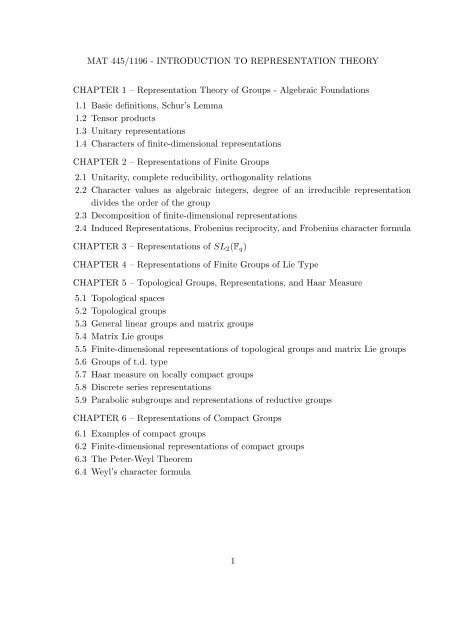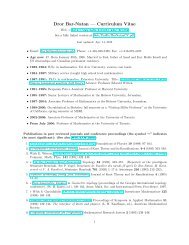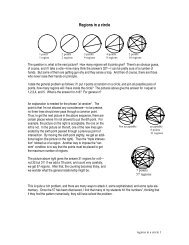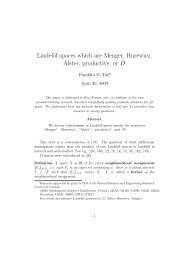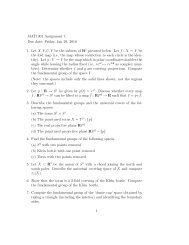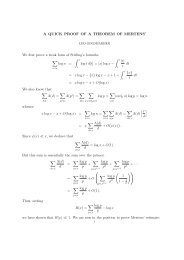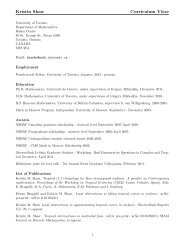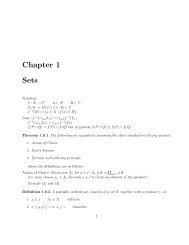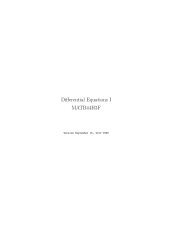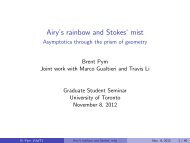MAT 445/1196 - INTRODUCTION TO REPRESENTATION THEORY ...
MAT 445/1196 - INTRODUCTION TO REPRESENTATION THEORY ...
MAT 445/1196 - INTRODUCTION TO REPRESENTATION THEORY ...
You also want an ePaper? Increase the reach of your titles
YUMPU automatically turns print PDFs into web optimized ePapers that Google loves.
<strong>MAT</strong> <strong>445</strong>/<strong>1196</strong> - <strong>INTRODUCTION</strong> <strong>TO</strong> <strong>REPRESENTATION</strong> <strong>THEORY</strong><br />
CHAPTER 1 – Representation Theory of Groups - Algebraic Foundations<br />
1.1 Basic definitions, Schur’s Lemma<br />
1.2 Tensor products<br />
1.3 Unitary representations<br />
1.4 Characters of finite-dimensional representations<br />
CHAPTER 2 – Representations of Finite Groups<br />
2.1 Unitarity, complete reducibility, orthogonality relations<br />
2.2 Character values as algebraic integers, degree of an irreducible representation<br />
divides the order of the group<br />
2.3 Decomposition of finite-dimensional representations<br />
2.4 Induced Representations, Frobenius reciprocity, and Frobenius character formula<br />
CHAPTER 3 – Representations of SL2(Fq)<br />
CHAPTER 4 – Representations of Finite Groups of Lie Type<br />
CHAPTER 5 – Topological Groups, Representations, and Haar Measure<br />
5.1 Topological spaces<br />
5.2 Topological groups<br />
5.3 General linear groups and matrix groups<br />
5.4 Matrix Lie groups<br />
5.5 Finite-dimensional representations of topological groups and matrix Lie groups<br />
5.6 Groups of t.d. type<br />
5.7 Haar measure on locally compact groups<br />
5.8 Discrete series representations<br />
5.9 Parabolic subgroups and representations of reductive groups<br />
CHAPTER 6 – Representations of Compact Groups<br />
6.1 Examples of compact groups<br />
6.2 Finite-dimensional representations of compact groups<br />
6.3 The Peter-Weyl Theorem<br />
6.4 Weyl’s character formula<br />
1
CHAPTER 1<br />
Representation Theory of Groups - Algebraic Foundations<br />
1.1. Basic definitions, Schur’s Lemma<br />
We assume that the reader is familiar with the fundamental concepts of abstract group<br />
theory and linear algebra. A representation of a group G is a homomorphism from G to<br />
the group GL(V ) of invertible linear operators on V , where V is a nonzero complex vector<br />
space. We refer to V as the representation space of π. If V is finite-dimensional, we say<br />
that π is finite-dimensional, and the degree of π is the dimension of V . Otherwise, we say<br />
that π is infinite-dimensional. If π is one-dimensional, then V C and we view π as a<br />
homomorphism from G to the multiplicative group of nonzero complex numbers. In the<br />
above definition, G is not necessarily finite. The notation (π, V ) will often be used when<br />
referring to a representation.<br />
Examples:<br />
(1) If G is a group, we can define a one-dimensional representation of G by π(g) = 1,<br />
g ∈ G. This representation is called the trivial representation of G.<br />
(2) Let G = R and z ∈ C. The function t ↦→ e zt defines a one-dimensional representation<br />
of G.<br />
If n is a positive integer and C is the field of complex numbers, let GLn(C) denote<br />
the group of invertible n × n matrices with entries in C. If (π, V ) is a finite-dimensional<br />
representation of G, then, via a choice of ordered basis β for V , the operator π(g) ∈ GL(V )<br />
is identified with the element [π(g)]β of GLn(C), where n is the degree of π. Hence we<br />
may view a finite-dimensional representation of G as a homomorphism from G to the group<br />
GLn(C).<br />
Examples:<br />
(1) The self-representation of GLn(C) is the n-dimensional representation defined by<br />
π(g) = g.<br />
(2) The function g ↦→ det g is a one-dimensional representation of GLn(C).<br />
(3) Let V be a space of functions from G to some complex vector space. Suppose that V<br />
has the property that whenever f ∈ V , the function g0 ↦→ f(g0g) also belongs to V<br />
for all g ∈ G. Then we may define a representation (π, V ) by (π(g)f)(g0) = f(gg0),<br />
f ∈ V , g, g0 ∈ G. For example, if G is a finite group, we may take V to be the space of<br />
all complex-valued functions on G. In this case, the resulting representation is called<br />
the right regular representation of G.<br />
Let (π, V ) be a representation of G. A subspace W of V is stable under the action<br />
of G, or G-invariant, if π(g)w ∈ W for all g ∈ G and w ∈ W . In this case, denoting the<br />
2
estriction of π(g) to W by π |W (g), (π |W , W ) is a representation of G, and we call it a<br />
subrepresentation of π (or a subrepresentation of V ).<br />
If W ′ ⊂ W are subrepresentations of π, then each π |W (g), g ∈ G, induces an invertible<br />
linear operator π W/W ′(g) on the quotient space W/W ′ , and (π W/W ′, W/W ′ ) is a<br />
representation of G, called a subquotient of π. In the special case W = V , it is called a<br />
quotient of π.<br />
A representation (π, V ) of G is finitely-generated if there exist finitely many vectors<br />
v1, . . . , vm ∈ V such that V = Span{ π(g)vj | 1 ≤ j ≤ m, g ∈ G }. A representation<br />
(π, V ) of G is irreducible if {0} and V are the only G-invariant subspaces of V . If π is not<br />
irreducible, we say that π is reducible.<br />
Suppose that (πj, Vj), 1 ≤ j ≤ ℓ, are representations of a group G. Recall that an<br />
element of the direct sum V = V1 ⊕ · · · ⊕ Vℓ can be represented uniquely in the form<br />
v1 + v2 + · · · + vℓ, where vj ∈ Vj. Set<br />
π(g)(v1 + · · · + vℓ) = π1(g)v1 + · · · + πℓ(g)vℓ, g ∈ G, vj ∈ Vj, 1 ≤ j ≤ ℓ.<br />
This defines a representation of G, called the direct sum of the representations π1, . . . , πℓ,<br />
sometimes denoted by π1 ⊕ · · · ⊕ πℓ. We may define infinite direct sums similarly. We<br />
say that a representation π is completely reducible (or semisimple) if π is (equivalent to) a<br />
direct sum of irreducible representations.<br />
Lemma. Suppose that (π, V ) is a representation of G.<br />
(1) If π is finitely-generated, then π has an irreducible quotient.<br />
(2) π has an irreducible subquotient.<br />
Proof. For (1), consider all proper G-invariant subspaces W of V . This set is nonempty<br />
and closed under unions of chains (uses finitely-generated). By Zorn’s Lemma, there is a<br />
maximal such W . By maximality of W , π V/W is irreducible.<br />
Part (2) follows from part (1) since of v is a nonzero vector in V , part (1) says that<br />
if W = Span{ π(g)v | g ∈ G }, then π |W has an irreducible quotient. qed<br />
Lemma. Let (π, V ) be a finite-dimensional representation of G. Then there exists an<br />
irreducible subrepresentation of π.<br />
Proof. If V is reducible, there exists a nonzero G-invariant proper subspace W1 of V . If<br />
π |W1 is irreducible, the proof is complete. Otherwise, there exists a nonzero G-invariant<br />
subspace W2 of W1. Note that dim(W2) < dim(W1) < dim(V ). Since dim(V ) < ∞, this<br />
process must eventually stop, that is there exist nonzero subspaces Wk Wk−1 · · · <br />
W1 V , where π |Wk is irreducible. qed<br />
Lemma. Let (π, V ) be a representation of G. Assume that there exists an irreducible<br />
subrepresentation of π. The following are equivalent:<br />
3
(1) (π, V ) is completely reducible.<br />
(2) For every G-invariant subspace W ⊂ V , there exists a G-invariant subspace W ′ such<br />
that W ⊕ W ′ = V .<br />
Proof. Assume that π is completely reducible. Without loss of generality, π is reducible.<br />
Let W be a proper nonzero G-invariant subspace of V . Consider the set of G-invariant<br />
subspaces U of V such that U ∩W = {0}. This set is nonempty and closed under unions of<br />
chains, so Zorn’s Lemma implies existence of a maximal such U. Suppose that W ⊕U = V .<br />
Since π is completely reducible, there exists some irreducible subrepresentation U ′ such<br />
that U ′ ⊂ W ⊕U. By irreduciblity of U ′ , U ′ ∩(W ⊕U) = {0}. This contradicts maximality<br />
of U.<br />
Suppose that (2) holds. Consider the partially ordered set of direct sums of families of<br />
irreducible subrepresentations: <br />
α Wα = ⊕αWα. Zorn’s Lemma applies. Let W = ⊕αWα<br />
be the direct sum for a maximal family. By (2), there exists a subrepresentation U such<br />
that V = W ⊕ U. If U = {0}, according to a lemma above, there exists an irreducible<br />
subquotient: U ⊃ U1 ⊃ U2 such that π U1/U2 is is irreducible. By (2), W ⊕ U2 has a<br />
G-invariant complement U3: V = W ⊕ U2 ⊕ U3. Now<br />
U3 V/(W ⊕ U2) = (W ⊕ U)/(W ⊕ U2) U/U2 ⊃ U1/U2.<br />
Identifying πU1/U2 with an irreducible subrepresentation π |U4 of π |U3 , we have W ⊕ U4<br />
contradicting maximality of the family Wα. qed<br />
Lemma. Subrepresentations and quotient representations of completely reducible representations<br />
are completely reducible.<br />
Proof. Let (π, V ) be a completely reducible representation of G. Suppose that W is a<br />
proper nonzero G-invariant subspace of W . Then, according to the above lemma, there<br />
exists a G-invariant subspace U of V such that V = W ⊕ U. It follows that the subrepresentation<br />
π |W is equivalent to the quotient representation π V/U . Therefore it suffices to<br />
prove that any quotient representation of π is completely reducible.<br />
Let π V/U be an arbitrary quotient representation of π. We know that π = ⊕α∈Iπα,<br />
where I is some indexing set, and each πα is irreducible. Let pr : V → V/U be the<br />
canonical map. Then V/U = pr(V ) = ⊕α∈Ipr(Vα). Because pr(Vα) is isomorphic to a<br />
quotient of Vα (pr(Vα) Vα/ker (pr | Vα)) and πα is irreducible, we have that pr(Vα) is<br />
either 0 or irreducible. Hence π V/U is completely reducible. qed<br />
Exercises:<br />
(1) Show that the self-representation of GLn(C) is irreducible.<br />
<br />
1 t<br />
(2) Verify that π : t ↦→ defines a representation of R, with space C<br />
0 1<br />
2 , that is a<br />
two-dimensional representation of R. Show that there is exactly one one-dimensional<br />
4
subrepresentation, hence π is not completely reducible. Prove that the restriction of<br />
π to the unique one-dimensional invariant subspace W is the trivial representation,<br />
and the quotient representation π V/W is the trivial representation.<br />
If (π1, V1) and (π2, V2) are representations of a group G, a linear transformation A :<br />
V1 → V2 intertwines π1 and π2 if Aπ1(g)v = π2(g)Av for all v ∈ V1 and g ∈ G. The notation<br />
Hom G(π1, π2) or Hom G(V1, V2) will be used to denote the set of linear transformations<br />
from V1 to V2 that intertwine π1 and π2. Two representations (π1, V1) and (π2, V2) of a<br />
group G are said to be equivalent (or isomorphic) whenever Hom G(π1, π2) contains an<br />
isomorphism, that is, whenever there exists an invertible linear tranformation A : V1 → V2<br />
that intertwines π1 and π2. In this case, we write π1 π2. It is easy to check that<br />
the notion of equivalence of representations defines an equivalence relation on the set of<br />
representations of G. It follows from the definitions that if π1 and π2 are equivalent<br />
representations, then π1 is irreducible if and only if π2 is irreducible. More generally, π1 is<br />
completely reducible if and only if π2 is completely reducible.<br />
Lemma. Suppose that (π1, V1) and (π2, V2) are finite-dimensional representations of G.<br />
Then the following are equivalent:<br />
(1) π1 and π2 are equivalent.<br />
(2) dim V1 = dim V2 and there exist ordered bases β1 and β2 of V1 and V2, respectively,<br />
such that [π1(g)]β1 = [π2(g)]β2 for all g ∈ G.<br />
Proof. Assume (1). Fix ordered bases γ1 for V1 and γ2 for V2. Via these bases, identifying<br />
any invertible operator in Hom G(π1, π2) as a matrix A in GLn(C), we have<br />
[π1(g)]γ1 = A −1 [π2(g)]γ2A, ∀ g ∈ G.<br />
Let β1 = γ1. Because A ∈ GLn(C), there exists an ordered basis β2 of V2 such that A is<br />
the change of basis matrix from β2 to γ2. With these choices of β1 and β2, (2) holds.<br />
Now assume that (2) holds. Let A be the unique linear transformation from V1 to V2<br />
which maps the jth vector in β1 to the jth vector in β2. qed<br />
A representation (π, V ) of G has a (finite) composition series if there exist G-invariant<br />
subspaces Vj of V such that<br />
{0} V1 · · · Vr = V<br />
each subquotient π Vj+1/Vj , 1 ≤ j ≤ r − 1, is irreducible. The subquotients π Vj+1/Vj are<br />
called the composition factors of π.<br />
Lemma. Let (π, V ) be a finite-dimensional represntation of G. Then π has a composition<br />
series. Up to reordering and equivalence, the composition factors of π are unique.<br />
Proof left as an exercise.<br />
5
Schur’s Lemma. Let (π1, V1) and (π2, V2) be irreducible representations of G. Then any<br />
nonzero operator in Hom G(π1, π2) is an isomorphism.<br />
Proof. If Hom G(π1, π2) = {0} there is nothing to prove, so assume that it is nonzero.<br />
Suppose that A ∈ Hom G(π1, π2) is nonzero. Let g ∈ G and v2 ∈ A(V1). Writing v2 =<br />
A(v1), for some v1 ∈ V1, we have π2(g)v2 = Aπ(g)v1 ∈ A(V1). Hence A(V1) is a nonzero<br />
G-invariant subspace of V2. By irreducibility of π2, we have A(V1) = V2.<br />
Next, let W be the kernel of A. Let v1 ∈ W . Then A(π1(g)v1) = π2(g)(A(v1)) =<br />
π1(g)0 = 0 for all g ∈ G. Hence W is a G-invariant proper subspace of V1. By irreducibility<br />
of π1, W = {0}. qed<br />
Corollary. Let (π, V ) be a finite-dimensional irreducible representation of G. Then<br />
Hom G(π, π) consists of scalar multiples of the identity operator, that is, Hom G(π, π) C.<br />
Proof. Let A ∈ Hom G(π, π). Let λ ∈ C be an eigenvalue of A (such an eigenvalue<br />
exists, since V is finite-dimensional and C is algebraically closed). It is easy to see that<br />
A − λI ∈ Hom G(π, π). But A − λI is not invertible. By the previous lemma, A = λI. qed<br />
Corollary. If G is an abelian group, then every irreducible finite-dimensional representation<br />
of G is one-dimensional.<br />
Proof left as an exercise.<br />
Exercise: Prove that an irreducible representation of the cyclic group of order n > 1,<br />
with generator g0, has the form g k 0 ↦→ e 2πimk/n for some m ∈ { 0, 1, . . . , n − 1 }. (Here i is<br />
a complex number such that i 2 = −1 and π denotes the area of a circle of radius one).<br />
Let (π, V ) be a representation of G. A matrix coefficient of π is a function from G<br />
to C of the form g ↦→ λ(π(g)v), for some fixed v ∈ V and λ in the dual space V ∨ of<br />
linear functionals on V . Suppose that π is finite-dimensional. Choose an ordered basis<br />
β = { v1, . . . , vn } of V . Let β ∨ = { λ1, . . . , λn } be the basis of V ∨ which is dual to β:<br />
λj(vi) = δij, 1 ≤ i, j ≤ n. Define a function aij : G → C by [π(g)]β = (aij(g))1≤i,j≤n.<br />
Then it follows from π(g)vi = n<br />
ℓ=1 aiℓ(g)vℓ that aij(g) = λj(π(g)vi), so aij is a matrix<br />
coefficient of π.<br />
If g ∈ G and λ ∈ V ∨ , define π ∨ (g)λ ∈ V ∨ by (π ∨ (g)λ)(v) = λ(π(g −1 )v), v ∈ V . Then<br />
(π ∨ , V ∨ ) is a representation of G, called the dual (or contragredient) of π.<br />
Exercises:<br />
(1) Let (π, V ) be a finite-dimensional representation of G. Choose β and β∨ as above.<br />
Show that [π∨ (g)]β∨ = [π(g−1 )] t β , for all g ∈ G. Here the superscript t denotes<br />
transpose.<br />
(2) Prove that if (π, V ) is finite-dimensional then π is irreducible if and only if π∨ is<br />
irreducible.<br />
6
(3) Determine whether the self-representation of GLn(R) (restrict the self-representation<br />
of GLn(C) to the subgroup GLn(R)) is equivalent to its dual.<br />
(4) Prove that a finite-dimensional representation of a finite abelian group is the direct<br />
sum of one-dimensional representations.<br />
1.2. Tensor products<br />
Let (πj, Vj) be a representation of a group Gj, j = 1, 2. Recall that V1 ⊗V2 is spanned<br />
by elementary tensors, elements of the form v1 ⊗ v2, v1 ∈ V1, v2 ∈ V2. We can define a<br />
representation π1 ⊗ π2 of the direct product G1 × G2 by setting<br />
(π1 ⊗ π2)(g1, g2)(v1 ⊗ v2) = π1(g1)v1 ⊗ π2(g2)v2, gj ∈ Gj, vj ∈ Vj, j = 1, 2,<br />
and extending by linearity to all of V1 ⊗ V2. The representation π1 ⊗ π2 of G1 × G2 is<br />
called the (external or outer) tensor product of π1 and π2. Of course, when π1 and π2 are<br />
finite-dimensional, the degree of π1 ⊗ π2 is equal to the product of the degrees of π1 and<br />
π2.<br />
Lemma. Let (πj, Vj) and Gj, j = 1, 2 be as above. Assume that each πj is finitedimensional.<br />
Then π1 ⊗ π2 is an irreducible representation of G1 × G2 if and only if π1<br />
and π2 are both irreducible.<br />
Proof. If π1 or π2 is reducible, it is easy to see that π1 ⊗ π2 is also reducible.<br />
Assume that π1 is irreducible. Let n = dim V2. Let<br />
Hom G1(π1, π1) n = Hom G1(π1, π1) ⊕ · · · ⊕ Hom G1(π1, π1),<br />
and πn 1 = π1 ⊕ · · · ⊕ π1, where each direct sum has n summands. Then Hom G1 (π1, π1) n <br />
Hom G1 (π1, πn 1 ), where the isomorphism is given by A1⊕· · ·⊕An ↦→ B, with B(v) = A1(v)⊕<br />
· · · ⊕ An(v). By (the corollary to) Schur’s Lemma, Hom G1(π1, π1) C. Irreducibility of<br />
π1 guarantees that given any nonzero v ∈ V1, V1 = Span{ π1(g1)v | g1 ∈ G1 }, and this<br />
implies surjectivity.<br />
Because V2 Cn and C Hom G1(π1, π1), we have<br />
(i) V2 Hom G1 (π1, π1 ⊗ 1 n ),<br />
where π1 ⊗ 1 n is the representation of G1 on V1 ⊗ V2 defined by (π1 ⊗ 1 n )(g1)(v1 ⊗ v2) =<br />
π1(g1)v1 ⊗ v2, v1 ∈ V1, v2 ∈ V2. (Note that this representation can be identified with the<br />
restriction of π1 ⊗ π2 to the subgroup G1 × {1} of G1 × G2).<br />
If m is a positive integer, then<br />
(ii)<br />
V1 ⊗ Hom G1 (π1, π m 1 ) → V m<br />
1<br />
v ⊗ A ↦→ A(v)<br />
7
is an isomorphism.<br />
Next, we can use (i) and (ii) to show that<br />
{ G1 − invariant subspaces of V1 ⊗ V2 } ↔ { C − subspaces of V2 }<br />
V1 ⊗ W ← W<br />
X →Hom G1 (π1, X) ⊂ Hom G1 (π1, π1 ⊗ 1 n ) = V2<br />
As any (G1 × G2)-invariant subspace X of V1 ⊗ V2 is also a G1-invariant subspace, we have<br />
X = V1 ⊗ W for some complex subspace W of V2. If X = {0} and π2 is irreducible, then<br />
Span{ (π1 ⊗ π2)(1, g2)X | g2 ∈ G2 } = V1 ⊗ Span{ π2(g2)W | g2 ∈ G2 } = V1 ⊗ V2.<br />
But G1 × G2-invariance of X then forces X = V1 ⊗ V2. It follows that if π1 and π2 are<br />
irreducible, then π1 ⊗ π2 is irreducible (as a representation of G1 × G2). qed<br />
Proposition. Let (π, V ) be an irreducible finite-dimensional representation of G1 × G2.<br />
Then there exist irreducible representations π1 and π2 of G1 and G2, respectively, such<br />
that π π1 ⊗ π2.<br />
Proof. Note that π ′ 1(g1)v = π((g1, 1))v, g1 ∈ G1, v ∈ V , and π ′ 2(g2)v = π((1, g2))v,<br />
g2 ∈ G2, v ∈ V , define representations of G1 and G2, respectively. Choose a nonzero<br />
G1-invariant subspace V1 such that π ′ 1 |V1 is an irreducible representation of G1. Let v0 be<br />
a nonzero vector in V1. Let<br />
V2 = Span{ π ′ 2(g2)v0 | g2 ∈ G2 }.<br />
Then V2 is G2-invariant and π2 := π ′ 2 |V2 is a representation of G2, which might be reducible.<br />
Define A : V1 ⊗V2 → V as follows. Let v1 ∈ V1 and v2 ∈ V2. Then there exist complex<br />
numbers cj and elements g (j)<br />
1 ∈ G1 such that v1 = m<br />
j=1<br />
numbers bℓ and elements g (ℓ)<br />
2 ∈ G2 such that v2 = n<br />
ℓ=1<br />
Now π(g (j)<br />
1<br />
, g(ℓ) 2 )v0 = π1(g (j)<br />
1<br />
A(v1 ⊗ v2) =<br />
)π2(g (ℓ)<br />
m<br />
n<br />
j=1 ℓ=1<br />
2 )v0 = π2(g (ℓ)<br />
2<br />
cjπ1(g (j)<br />
1 )v0, as well as complex<br />
bℓπ2(g (ℓ)<br />
2<br />
cjbℓπ(g (j)<br />
1 , g(ℓ) 2 )v0.<br />
). Set<br />
)π1(g (j)<br />
1 )v0. Check that the map A is<br />
well-defined, extending to a linear transformation from V1 ⊗ V2 to V . Also check that<br />
A ∈ Hom G1×G2 (V1 ⊗ V2, V ).<br />
Because A(v0 ⊗ v0) = v0, we know that A is nonzero. Combining G1 × G2-invariance<br />
of A(V1 ⊗ V2) with irreducibility of π, we have A(V1 ⊗ V2) = V . If A also happens to be<br />
one-to-one, then we have π1 ⊗ π2 π.<br />
8
Suppose that A is not one-to-one. Then Ker A is a G1 × G2-invariant subspace of<br />
V1 ⊗ V2. In particular, Ker A is a G1-invariant subspace of V1 ⊗ V2. Using irreducibility<br />
of π1 and arguing as in the previous proof, we can conclude that Ker A = V1 ⊗ W for<br />
some complex subspace W of V2. We have an equivalence of the representations (π1 ⊗<br />
π2) (V1⊗V2)/Ker A and π of G1 × G2. To finish the proof, we must show that the quotient<br />
representation (π1 ⊗ π2) V/(V1⊗W ) is a tensor product. If v1 ∈ V1 and v2 ∈ V2, define<br />
B(v1 ⊗ (v1 + W )) = v1 ⊗ v2 + V1 ⊗ W.<br />
This extends by linearity to a map from V1 ⊗(V2/W ) to the quotient space (V1 ⊗V2)/(V1 ⊗<br />
W ) and it is a simple matter to check that B is an isomorphism and B ∈ Hom G1×G1 (π1 ⊗<br />
(π2) V2/W , (π1 ⊗ π2) (V1⊗V2)/(V1⊗W ). The details are left as an exercise. qed<br />
If (π1, V1) and (π2, V2) are representations of a group G, then we may form the tensor<br />
product representation π1 ⊗π2 of G×G and restrict to the subgroup δG = { (g, g) | g ∈ G }<br />
of G×G. This restriction is then a representation of G, also written π1 ⊗π2. It is called the<br />
(inner) tensor product of π1 and π2. Using inner tensor products gives ways to generate<br />
new representations of a group G. However, it is important to note that even if π1 and π2<br />
are both irreducible, the inner tensor product representation π1 ⊗π2 of G can be reducible.<br />
Exercise: Let π1 and π2 be finite-dimensional irreducible representations of a group G.<br />
Prove that the trivial representation of G occurs as a subrepresentation of the (inner)<br />
tensor product representation π1 ⊗ π2 of G if and only if π2 is equivalent to the dual π ∨ 1<br />
of π.<br />
1.3. Unitary representations<br />
Suppose that (π, V ) is a representation of G. If V is a finite-dimensional inner product<br />
space and there exists an inner product 〈·, ·〉 on V such that<br />
〈π(g)v1, π(g)v2〉 = 〈v1, v2〉, ∀ v1, v2 ∈ V, g ∈ G.<br />
then we say that π is a unitary representation. If V is infinite-dimensional, we say that<br />
π is pre-unitary if such an inner product exists, and if V is complete with respect to the<br />
norm induced by the inner product (that is, V is a Hilbert space), then we say that π is<br />
unitary.<br />
Now assume that π is finite-dimensional. Recall that if T is a linear operator on V ,<br />
the adjoint T ∗ of T is defined by < T (v), w >=< v, T ∗ (w) > for all v, w ∈ V . Note that<br />
π is unitary if and only if each operator π(g) satisfies π(g) ∗ = π(g) −1 , g ∈ G.<br />
Let n be a positive integer. Recall that if A is an n × n matrix with entries in C, the<br />
adjoint A ∗ of A is just A ∗ = t Ā.<br />
9
Lemma. If (π, V ) is a finite-dimensional unitary representation of G and β is an orthonormal<br />
basis of V , then [π(g)] ∗ β = [π(g)]−1 β .<br />
Proof. Results from linear algebra show that if T is a linear operator on V and β is an<br />
orthonormal basis of V , then [T ∗ ]β = [T ] ∗ β . Combining this with π(g)∗ = π(g) −1 , g ∈ G,<br />
proves the lemma. qed<br />
Exercises:<br />
(1) If (π, V ) is a representation, form a new vector space ¯ V as follows. As a set, V = ¯ V ,<br />
and ¯ V has the same vector addition as V . If c ∈ C and v ∈ ¯ V , set c · v = ¯cv, where ¯c<br />
is the complex conjugate of c and ¯cv is the scalar multiplication in V . If g ∈ G, and<br />
v ∈ ¯ V , ¯π(g)v = π(g)v. Show that (¯π, ¯ V ) is a representation of V .<br />
(2) Assume that (π, V ) is a finite-dimensional unitary representation. Prove that π ∨ ¯π.<br />
Lemma. Let W be a subspace of V , where (π, V ) is a unitary representation of G. Then<br />
W is G-invariant if and only if W ⊥ is G-invariant.<br />
Proof. W is G-invariant if and only if π(g)w ∈ W for all g ∈ G and w ∈ W if and only if<br />
〈π(g)w, w ⊥ 〉 = 0 for all w ∈ W , w ⊥ ∈ W ⊥ and g ∈ G if and only if 〈w, π(g −1 )w ⊥ 〉 = 0 for<br />
all w ∈ W , w ⊥ ∈ W ⊥ and g ∈ G, if and only if W ⊥ is G-invariant. qed<br />
Corollary. A finite-dimensional unitary representation is completely reducible.<br />
Lemma. Suppose that (π, V ) is a finite-dimensional unitary represetantion of G. Let W<br />
be a proper nonzero G-invariant subspace of V , and let PW be the orthogonal projection<br />
of V onto W . Then PW commutes with π(g) for all g ∈ G.<br />
Proof. Let w ∈ W and w ⊥ ∈ W ⊥ . Then<br />
qed<br />
PW π(g)(w + w ⊥ ) = PW π(g)w + PW π(g)w ⊥ = π(g)w + 0 = π(g)PW (w + w ⊥ ).<br />
Lemma. Let (π, V ) be a finite-dimensional unitary representation of G. Then π is irreducible<br />
if and only if Hom G(π, π) C (every operator which commutes with all π(g)’s is<br />
a scalar multiple of the identity operator).<br />
Proof. One direction is simply the corollary to Schur’s Lemma (using irreducibility of π).<br />
For the other, if π is reducible, and W is a proper nonzero G-invariant subspace of V ,<br />
Then PW ∈ Hom G(π, π) and PW is not a scalar multiple of the identity operator. qed<br />
Suppose that (π1, V1) and (π2, V2) are representations of G and V1 and V2 are complex<br />
inner product spaces, with inner products 〈·, ·〉1 and 〈·, ·〉2, respectively. Then π1 and π2<br />
are unitarily equivalent if there exists an invertible linear operator A : V1 → V2 such that<br />
〈Av, Aw〉2 = 〈v, w〉1 for all v and w ∈ V1 and A ∈ Hom G(π1, π2).<br />
10
Lemma. Let (π1, V1) and (π2, V2) be finite-dimensional unitary representations of G.<br />
Then π1 π2 if and only if π1 and π2 are unitarily equivalent.<br />
Proof. Assume that π1 π2. Let A : V1 → V2 be an isomorphism such that A ∈<br />
Hom G(π1, π2). Recall that the adjoint A ∗ : V2 → V1 is defined by the condition 〈A ∗ v2, v1〉1 =<br />
〈v2, Av1〉2 for all v1 ∈ V1 and v2 ∈ V2. By assumption, we have<br />
(i) π1(g) = A −1 π2(g)A, ∀ g ∈ G.<br />
Taking adjoints, we have π1(g) ∗ = A ∗ π2(g) ∗ (A ∗ ) −1 for all g ∈ G. Since πj is unitary, we<br />
have πj(g) ∗ = πj(g −1 ). Replacing g −1 by g, we have<br />
(ii) π1(g) = A ∗ π2(g)(A ∗ ) −1 , ∀ g ∈ G.<br />
Expressing π2(g) in terms of π1(g) using (i), we can rewrite (ii) as<br />
or<br />
π1(g) = A ∗ Aπ1(g)A −1 (A ∗ ) −1 , ∀ g ∈ G,<br />
π1(g) −1 A ∗ Aπ1(g) = A ∗ A, ∀ g ∈ G.<br />
Now A ∗ A is positive definite (that is, self-adjoint and having positive (real) eigenvalues),<br />
and so has a unique positive definite square root, say B. Note that π1(g) −1 Bπ1(g) is<br />
also a square root of A ∗ A and it is positive definite, using π1(g) ∗ = π1(g) −1 . Hence<br />
π1(g) −1 Bπ1(g) = B for all g ∈ G. Writing A in terms of the polar decomposition, we<br />
have A = UB, with B as above, and with U an isomorphism from V1 → V2 such that<br />
〈Uv, Uw〉2 = 〈v, w〉1 for all v and w ∈ V1. Next, note that<br />
π2(g) = UBπ1(g)B −1 U −1 = Uπ1(g)U −1 , ∀ g ∈ G.<br />
Hence U ∈ Hom G(π1, π2), and π1 and π2 are unitarily equivalent. qed<br />
1.4. Characters of finite-dimensional representations<br />
Let (π, V ) be a finite-dimensional representation of a group G. The function g ↦→<br />
tr π(g) from G to C is called the character of π. We use the notation χπ(g) = tr π(g). Note<br />
that we can use any ordered basis of V to compute χπ(g), since the trace of an operator<br />
depends only on the operator itself. Note that if π were infinite-dimensional, the operator<br />
π(g) would not have a trace.<br />
11
Lemma. Let (π, V ) be a finite-dimensional representation of G.<br />
(1) If π ′ π, then χπ = χπ ′.<br />
(2) The function χπ is constant on conjugacy classes in G.<br />
(3) Let π ∨ be the representation dual to π. Then χπ ∨(g) = χπ(g −1 ), g ∈ G.<br />
(4) If π is unitary, then χπ(g −1 ) = χπ(g), g ∈ G.<br />
(5) Suppose that (π, V ) has a composition series {0} V1 · · · Vr = V , with composition<br />
factors πV1 ,π V2/V1 , . . . , π Vr/Vr−1 (see page 5). Then χπ = χπV 1 + χπ V2 /V 1 + · · · +<br />
χπ Vr /V r−1 .<br />
(6) The character χπ1⊗···⊗πr of a tensor product of finite-dimensional representations<br />
π1, . . . , πr of G1, . . . , Gr, respectively, is given by<br />
χπ1⊗···⊗πr (g1, . . . , gr) = χπ1 (g1)χπ2 (g2) · · · χπr (gr), g1 ∈ G1, . . . , gr ∈ Gr.<br />
Proof. By an earlier result, if π ′ π, then π ′ and π have the same matrix realization (for<br />
some choice of bases). Part (1) follows immediately.<br />
Note that<br />
χπ(g1gg −1<br />
1 ) = tr (π(g1)π(g)π(g1) −1 ) = tr π(g) = χπ(g), g, g1 ∈ G.<br />
Recall that if β is an ordered basis of V and β ∨ is the basis of V ∨ dual to β, then<br />
[π(g)]β = t [π∨ (g−1 )]β∨. This implies (3).<br />
Suppose that π is unitary. Let β be an orthonormal basis of V . Then [π(g−1 )]β =<br />
[π(g)] ∗ β = t [π(g)] implies part (4).<br />
For (5), it is enough to do the case r = 2. Let β be an ordered basis for V1. Extend β<br />
to an ordered basis γ for V2 = V . Let ˙γ be the ordered basis for V2/V1 which is the image<br />
of γ under the canonical map V → V2/V1. Then it is easy to check that [π(g)]γ is equal to<br />
[π |V1 (g)]β<br />
∗<br />
0 [π V2/V1 (g)] ˙γ<br />
For (6), it is enough to do the case r = 2. Let β = { v1, . . . , vn} and γ = { w1, . . . , wm }<br />
be ordered bases of V1 and V2, respectively. Then<br />
<br />
.<br />
{ vj ⊗ wℓ | 1 ≤ j ≤ n, 1 ≤ ℓ ≤ m }<br />
is an ordered basis of V1 ⊗ V2. Let aij(g1) be the ijth entry of [π1(g1)]β, g1 ∈ G1, and let<br />
bij(g2) be the ijth entry of [π2(g2)]γ, g2 ∈ G2. We have<br />
π1(g1)vj = a1j(g1)v1 + a2j(g1)v2 + · · · + anj(g1)vn, g1 ∈ Gr<br />
π2(g2)wℓ = b1ℓ(g2)w1 + b2ℓ(g2)w2 + · · · + bmℓ(g2)wm, g2 ∈ G2.<br />
12
Hence<br />
π1(g1)vj ⊗ π2(g2)wℓ =<br />
n<br />
t=1 s=1<br />
m<br />
atj(g1)bsℓ(g2)(vt ⊗ ws),<br />
and, as the coefficient of vj ⊗ wℓ on the right side equals ajj(g1)bℓℓ(g2), we have<br />
χπ1⊗π2 (g1, g2) =<br />
n<br />
j=1 ℓ=1<br />
m<br />
ajj(g1)bℓℓ(g2) = χπ1 (g1)χπ2 (g2), g1 ∈ G1, g2 ∈ G2.<br />
Example: The converse to part (1) is false. Consider the Example (2) on page 4. We<br />
have χπ(t) = 2 for all t ∈ R. Now take π0 ⊕ π0, where π0 is the trivial representation of<br />
R. This clearly has the same character as π, though π0 ⊕ π0 is not equivalent to π.<br />
In many cases, for example, if G is finite, or compact, two irreducible finite-dimensional<br />
representations having the same character must be equivalent.<br />
13


